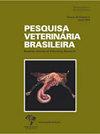Risk of arrhythmias in dogs with structural heart disease
IF 0.8
4区 农林科学
Q3 VETERINARY SCIENCES
引用次数: 0
Abstract
ABSTRACT: Presently, pet life expectancy is becoming longer and several diseases inherent to age have been diagnosed, with heart disease being a frequent finding. Although various heart diseases have different pathophysiologies, many morphological and hemodynamic changes can predispose patients to arrhythmias. The presence of arrhythmias can worsen the underlying heart disease and predispose patients to develop new alterations, making arrhythmia detection important for establishing adequate therapeutic protocols and a better prognosis. The present study aimed to determine the arrhythmias most frequently found in dogs treated at the Cardiology and Respiratory Diseases Service (SCDR) of the Small Animals Sector of the Veterinary Hospital of the Federal Rural University of Rio de Janeiro (UFRRJ), during the period from January to 2014 to December 2017, relating them to sex, age group, size, and the presence or absence of heart disease. A total of 586 medical records of dogs treated with SCDR-UFRRJ were retrospectively evaluated. Of these, 15.4% had arrhythmias, 95.6% had diagnoses of heart disease, 61.1% (55/90) were diagnosed with mitral valve disease, and 27.8% (25/90) had dilated cardiomyopathies. The most frequent rhythm disturbances were premature ventricular complexes associated with chronic degenerative mitral valve disease or dilated cardiomyopathy. Statistical analysis confirmed the risk of a cardiac patient developing rhythm or conduction alterations (OR, 4.46; p = 0.0003). In conclusion, the pathophysiology of heart failure can lead to the development of rhythm and conduction disorders.结构性心脏病犬的心律失常风险
摘要:目前,宠物的预期寿命越来越长,一些与年龄有关的疾病被诊断出来,其中心脏病是常见的发现。虽然各种心脏疾病有不同的病理生理,但许多形态学和血流动力学的改变可使患者易患心律失常。心律失常的存在可使潜在的心脏病恶化,并使患者易发生新的改变,因此心律失常检测对于建立适当的治疗方案和更好的预后非常重要。本研究旨在确定2014年1月至2017年12月期间在里约热内卢联邦农村大学兽医医院(UFRRJ)小动物部门心脏病学和呼吸疾病服务处(SCDR)治疗的狗中最常见的心律失常,并将其与性别、年龄组、体型和是否存在心脏病联系起来。回顾性分析586例经SCDR-UFRRJ治疗犬的病历。其中,15.4%患有心律失常,95.6%诊断为心脏病,61.1%(55/90)诊断为二尖瓣疾病,27.8%(25/90)诊断为扩张型心肌病。最常见的心律失常是与慢性退行性二尖瓣疾病或扩张性心肌病相关的过早心室复合体。统计分析证实了心脏病患者发生心律或传导改变的风险(or, 4.46;P = 0.0003)。综上所述,心衰的病理生理可导致心律和传导障碍的发展。
本文章由计算机程序翻译,如有差异,请以英文原文为准。
求助全文
约1分钟内获得全文
求助全文
来源期刊

Pesquisa Veterinaria Brasileira
农林科学-兽医学
CiteScore
1.30
自引率
16.70%
发文量
41
审稿时长
9-18 weeks
期刊介绍:
Pesquisa Veterinária Brasileira - Brazilian Journal of Veterinary Research (http://www.pvb.com.br), edited by the Brazilian College of Animal Pathology in partnership with the Brazilian Agricultural Research Organization (Embrapa) and in collaboration with other veterinary scientific associations, publishes original papers on animal diseases and related subjects. Critical review articles should be written in support of original investigation. The editors assume that papers submitted are not being considered for publication in other journals and do not contain material which has already been published. Submitted papers are peer reviewed.
The abbreviated title of Pesquisa Veterinária Brasileira is Pesqui. Vet. Bras.
 求助内容:
求助内容: 应助结果提醒方式:
应助结果提醒方式:


